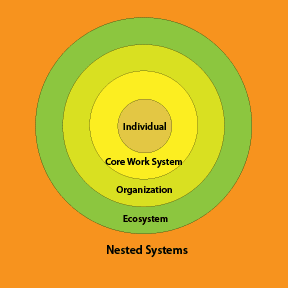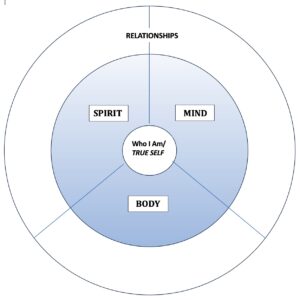Over the past five years, my colleagues and I at Socio-technical Systems Roundtable (STS-RT) explored, dialogued and prototyped our way towards a new model for designing and developing organizations — the Adaptive Enterprise. This body of international educators, managers, unionists and consultants recognizes complexity is better understood from the perspectives of many.
In the spirit of transparency and innovation, our four iterations of the Adaptive Enterprise model led us to speculate on this initial list of emerging characteristics.
Emerging Characteristics of Adaptive Enterprises
1. Self-organizing
- Shapes system evolution
- through an emergence and feedback process
- with limited (or no) hierarchy of command and control
- and limited (or no) planning and managing
Most futurists would agree we cannot predict the future. However we can, with conscious awareness and study, understand the past and the present in order to increase our certainty of emerging next steps. Cycles exist within all organisms and organic systems — the seasons, menses, birth to death, product innovation, organizational growth and development, etc. Through observing and understanding these self-organizing patterns, we learn as humans to adapt to the emerging opportunities and challenges presented within each phase of the cycle. To thrive under an operating principle of self-organization, a tremendous shift in humanity is required — from a belief that we know best to a belief that the ‘system’ under observation knows best its needs and reveals those needs as part of its evolutionary process. The real work for humanity is to shed our ego’s need for command and control and to let our planning and management be led by and limited to the feedback from these self-organizing systems.
2. Transformational
- Includes single-loop learning (incremental) – Behaviour change
- Includes double-loop learning (reframing assumptions) – Belief change
- Includes triple-loop learning (innovation & integration) – Being change
This transformational shift in humanity takes us beyond learning the simple mechanics of behaviour change that most organizations in today’s business world abide by. We know from decades of research that in order to create permanent release from behavioural patterns/addictions (dieting and smoking cessation), we need to address the source of the behaviour (our underlying beliefs and assumptions) not just the symptoms (overeating and smoking). Once we understand these often unconscious and disabling assumptions, we can consciously choose to reframe them into enabling beliefs. Similarly, for an organization that believes “doing what it has always done will bring continued success.” This organizational belief shows up in cultures of command and control, where status is determined by how much you earn rather than by how successful you are at creative ‘solutioning’; or where ‘we can only do what the budget allows’ rather than brainstorming outside the corporate box. Shifting an organization’s belief systems ultimately shifts its culture and identity, which when aligned with supporting structures and practices integrates this new identity into daily activities.
3. Simplicity
- Includes only those critical processes that integrate creating/innovating with conserving/sustaining (minimal critical specifications)
- Measured as good enough (excellence is built in with additional iterations)
- Minimally complex and not complicated (Assess, Act, Adapt)
In the design and development of an Adaptive Enterprise, simplicity of processes and structures is key for ensuring its rapid response ability. Boundaries are temporary and fluid to encourage continual morphing based on emerging needs, and excellence is measured as ‘good enough’ to meet immediate needs because those needs could and likely will change next month or next year.
4. Nested Systems
- Simultaneous intervention in all systems (individual, core work system, organization, ecosystem)
- Inclusion from across the nested systems builds resilience and innovation through diversity, requisite variety and interdependence
As we globally adapt to the beliefs “we are all connected” and “what we do to others, we do to ourselves,” what evolves is a greater responsibility to act holistically. From a whole system perspective, this includes considering, for any intervention, the individual, work system, organization and ecosystem repercussions. Engaging participation from across all effected systems encourages win-win results.

5. Rapid Prototyping
- Embraces uncertainty and unpredictability
- Integrates familiar STS principles and methodologies – variance control, incompletion, boundary location, multi-functionality and minimal critical specifications
In traditional organizational design and development, the belief held is “once the experts have perfected it, we can implement.” Because perfection takes too long and is unrealistic and because the world around us is changing at an ever-increasing speed, a new belief of ‘good enough’ is required. The practice of creating ever-improving iterations (think Apple products) through rapid prototyping of a product/service-offering by a diverse collaborative team marries innovation and optimization, which allows organizations to simultaneously exploit and explore opportunities.
6. Simultaneous exploration and exploitation
- Aligns optimization and innovation
- Integrates infinite feedback loops
- Coordinates along three co-occurring horizons —
1. 1st horizon (operational optimization of core businesses)
2. 2nd horizon (development of new products or businesses with resources attached but
not yet matured/optimized)
3. 3rd horizon (researching seeds of ideas for new businesses)
The increasing speed of change and the complexity of world markets and life in general require 21st century enterprises to strategize on two fronts — surviving and thriving. Survival in the business world implies the removal of rework and errors in all core business systems and processes. The resulting efficiency and effectiveness creates a stable foundation from which the enterprise optimizes its benefits and profit margin. These accrued resources feed and seed developing and new markets enabling the organization’s longevity and thrive-ability. Unlike Maslow’s belief where we must first satisfy our survival needs before we can satisfy higher-order development needs, today’s organizational complexity requires us to survive and self-actualize simultaneously.
In June 2011, my STS-RT colleagues and I will come together again to consider this ‘survival/self-actualization’ context and produce a fifth iteration of our Adaptive Enterprise model. What you see in today’s blog is the model’s emerging skeleton. The connective tissue, muscles and tendons that hold a skeleton together are our next iteration.
From your experience of organizational life, have we captured a ‘good enough’ framework to which we can now add more meat? What do you see as missing?




